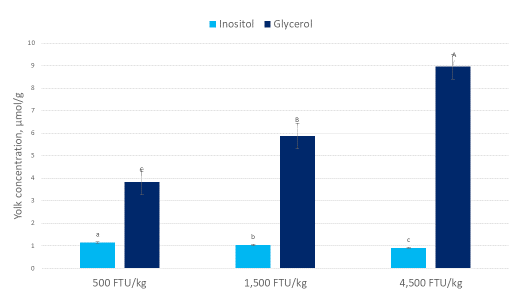By Rob ten Doeschate, Technical Director EMEA and Gustavo Cordero, Global Technical Manager AB Vista
Chickens have a limited ability to break down dietary phytate (IP6) but a substantial part of dietary phosphorus is bound in this form. Thus, exogenous phytase has been added to poultry diets to increase phosphorus release for decades now. Traditionally, phytase was used to release phosphorus; at that point, the phytase levels added to the diet were between 250 and 500 FTU/kg of diet. Higher doses of phytase (superdosing) are nowadays commonly used to move closer to full destruction of phytate (IP6) and its lower esters (IP5-IP1) and thus achieve “extra-phosphoric effects”. The use of superdosing in poultry diets started with broiler diets, where the concept is now well accepted by integrators and feed producers. When looking at more mature animals, like laying hens or breeders, the question is whether phytase superdosing would give similar benefits as older animals may suffer less from the antinutritional effects of phytate.
But there are several ways near complete destruction of phytate can benefit the animal: either through reduction of the direct antinutritional effect of phytate; or through improved protein and amino acid digestibility; or through improved availability of minerals other than phosphorus (Calcium, Iron, Zinc, Manganese etc); as well as through the production of inositol in situ in the animal after full dephosphorylation of phytate. Inositol, which has a wide range of functions in metabolism, is the backbone of the phytate molecule. One of the roles of inositol is to improve energy metabolism, helping animals utilise dietary energy more efficiently.
To achieve fast and near complete destruction of phytate a highly efficient phytase can be added at several times the normal dose. If the phytase can take IP6 down to IP1, this can then be hydrolysed by the animal’s own enzyme, alkaline phosphatase, releasing inositol. The release of inositol may have a critical role in the benefits observed from adding the higher phytase levels; inositol has been linked to enhancing mood, cell growth and survival, and development of peripheral nerves as well as roles in osteogenesis and reproduction. Past studies in commercial laying hens have shown benefits of superdosing in terms of improved productivity as well as improved yolk mineral levels. In broiler breeders an improvement in nutrient levels in the egg could translate to better hatch outcomes and chick quality. One challenge with broiler breeders is that nutrient and feed intake is normally restricted to avoid birds getting too fat so an improvement in nutrient availability from enzymes may need to be balanced by either adjusting diet composition or feed allowance. Where this is not done it should be noted that, whilst any response indicates that the concept of superdosing is working, sometimes an increased nutrient supply may mean a deterioration in production responses.
In a trial reported in two posters at ESPN 2019 it was investigated whether increasing phytase dose in broiler breeders had effects on hen performance, egg quality, hatchability and progeny performance. The phytase doses used were 500, 1500 and 4500 FTU/kg (Quantum Blue, AB Vista). The nutrient release accounted for in the diet formulation was 0.15% available phosphorus and 0.16% calcium, so any further improvement in nutrient availability such as amino acids, energy or trace minerals would have a direct effect on the nutrient supply of the birds. The trial lasted from 27 until 50 weeks of age, with 18 pens of four hens per experimental treatment. Levels of nutrients in eggs were determined at 35 and 40 weeks of age whilst hatchability and performance of chicks was based on eggs produced when hens were 38 weeks of age.
Whilst egg production was within expected levels for all groups, the 1500 FTU/kg group performed best with an overall production of 5.35 eggs/week which was significantly (P<0.05) higher than the 4500 FTU/ kg group at 5.21 eggs/week with the 500 FTU/kg group intermediate at 5.29 eggs/week. External egg quality was equal across all dietary groups but there were effects of diet as well as age on yolk nutrient levels. With regards to minerals, there were significant differences as a result of both dietary treatments as well age of the hens and some interaction between age and diet which confused the picture. Calcium and Copper were highest at 1500 FTU/kg whilst Phosphorus was lowest.

Zinc increased with increasing phytase dose. Inositol and glycerol in the egg yolk responded clearly to the increasing dietary phytase level, with glycerol increasing but inositol decreasing (Figure 1). This may be the result of conversion of inositol to triglycerides, which could then be utilised by the chick at hatch. When incubating the eggs it was found that increasing phytase levels resulted in lower % late dead and a lower % dead in shell after pipping, which supports the hypothesis that energy supply for hatching may have been improved. Early dead % was increased though, resulting in equal overall hatchability. Inositol in the yolk sac at day of hatch showed an increase with the highest dose of phytase, which may have been used by the embryo as an energy source during hatching.

When the chicks that hatched were grown on it was found that chicks from hens fed higher phytase levels were heavier at 7 days post hatch, indicating that the hen’s diet supported better growth of the progeny (FIgure 2).

weight (g) at 0 and 7 days of age
This work allows us to conclude that the principle of using high doses of phytase to achieve near complete breakdown of phytate also works in adult breeder hens and that this can achieve nutritional benefits. It is highly likely that, when applying this in practice in broiler breeders, this is best combined with some further nutrient reduction in the diet, especially with regards to essential amino acids so as not to not allow egg size increases.
For further information or references please contact